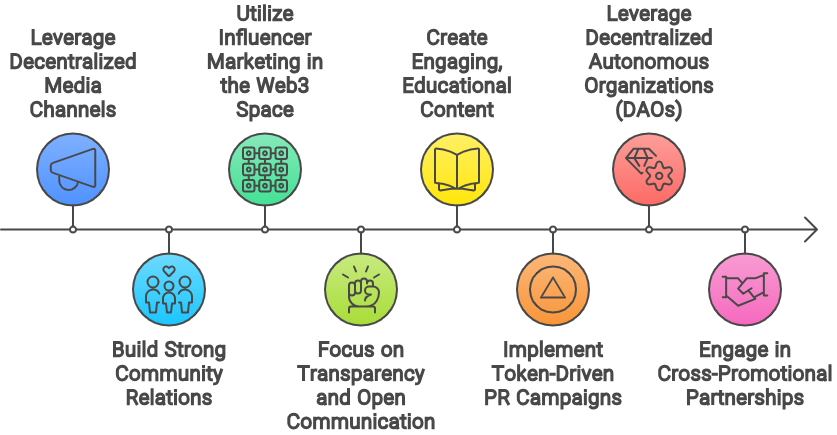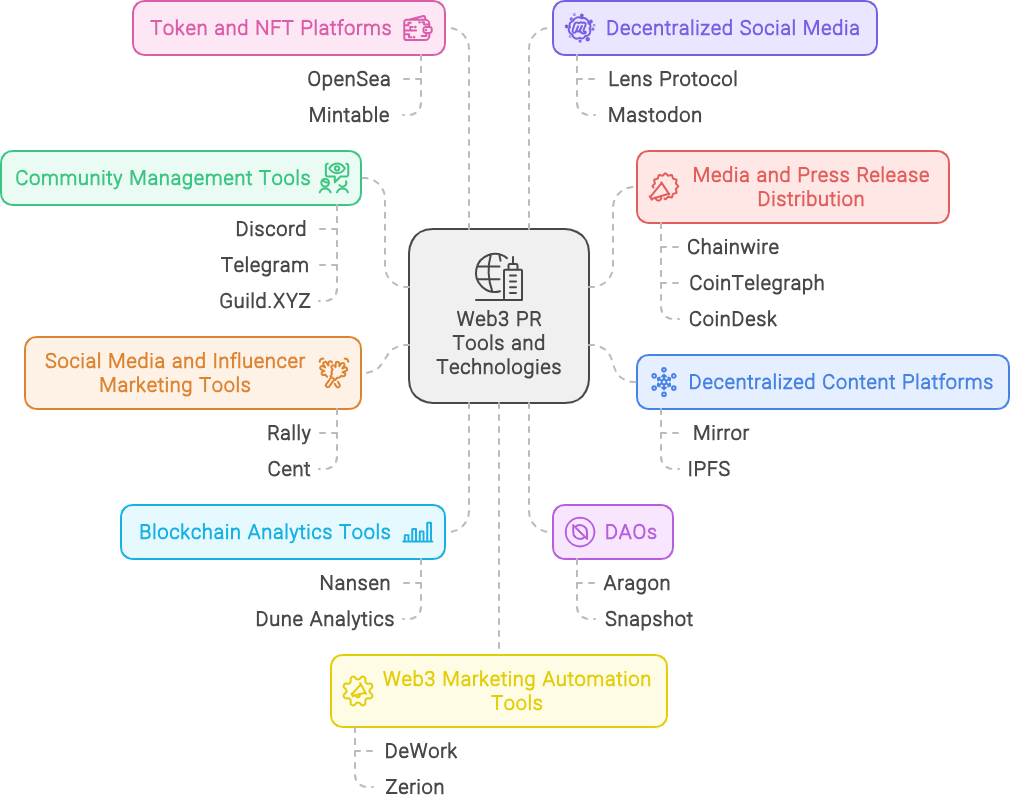Web3 Go-to-Market: An Ultimate Guide and Tactics for Web3 Applications
Web3 PR marketing is revolutionizing the way brands connect with audiences in the decentralized digital landscape of 2024. Traditional PR approaches rapidly evolve as blockchain technology and decentralized platforms gain prominence. This guide offers a comprehensive overview of Web3 PR marketing, providing insights into the unique strategies and tools essential for success in this new era. Whether you’re a startup or an established enterprise, understanding how to navigate Web3 effectively can significantly enhance your brand’s visibility, credibility, and engagement.
 FIg: Web3 PR Marketing
FIg: Web3 PR MarketingFrom leveraging decentralized social networks to utilizing smart contracts for transparent influencer partnerships, Web3 PR marketing demands a fresh perspective and innovative techniques. As the lines between digital ownership, content creation, and brand communication blur, mastering Web3 PR strategies is crucial for staying competitive and relevant. This ultimate guide will equip you with the knowledge and skills needed to harness the full potential of Web3 PR marketing, ensuring your brand thrives in the decentralized world of 2024 and beyond.
Table of ContentWhat is Web3 PR Marketing?Core Components of Web3 PR Marketing
Effective Web3 PR Marketing Strategies
Tools and Technologies for Web3 PR
Measuring Success in Web3 PR
Key Challenges in Web3 PR Marketing
Future Trends in Web3 PR Marketing
ConclusionWhat is Web3 PR Marketing?
Web3 PR marketing refers to the strategies and practices used to promote brands and manage public relations within the decentralized ecosystem of Web3, the next generation of the Internet. Unlike traditional PR, which relies on centralized platforms and intermediaries, Web3 PR leverages blockchain technology, decentralized networks, and peer-to-peer interactions to connect directly with audiences. This approach emphasizes transparency, trust, and community engagement, as brands can interact more authentically with their audiences through decentralized social media, NFTs, and tokenized incentives.
Smart contracts enable automated and transparent collaborations with influencers and partners, ensuring accountability and fairness in brand promotions. Web3 PR marketing also involves navigating the complexities of decentralized governance, where communities have more control over content and brand narratives. As the digital landscape evolves, Web3 PR marketing is becoming essential for brands looking to build credibility and loyalty in a more decentralized and user-empowered environment. It’s a forward-thinking approach that aligns with the values of privacy, ownership, and transparency at the core of Web3.
Core Components of Web3 PR MarketingWeb3 PR marketing is a specialized approach that focuses on decentralized web and blockchain-based projects. Here are the core components of Web3 PR marketing:
1. Community Building and Engagement- Decentralized Communities: Engage with decentralized communities on platforms like Discord, Telegram, and other blockchain-based social networks.
- Influencer Partnerships: Collaborate with influencers who are respected in the Web3 space to build trust and credibility.
- User-Generated Content: Encourage community members to create and share content, fostering organic growth and brand loyalty.
- Content Platforms: Utilize decentralized content platforms like Mirror or IPFS to distribute content that aligns with Web3 values.
- Tokenized Content: Create and distribute tokenized content (e.g., NFTs) that offers unique value to your audience and incentivizes engagement.
- Open Communication: Maintain transparent communication with your audience through regular updates, AMAs (Ask Me Anything), and open forums.
- On-Chain Proofs: Use on-chain data and proofs to validate claims, such as partnership announcements or milestone achievements.
- Web3 Influencers: Partner with influencers who have a strong presence in the Web3 space to amplify your message.
- Collaborative Content: Co-create content with thought leaders in the blockchain and Web3 space to enhance credibility and reach.
- Virtual Events: Participate in or host virtual events, such as webinars, conferences, and meetups, that cater to the Web3 community.
- Hackathons and Competitions: Sponsor or organize hackathons and competitions that encourage innovation and attract talent within the Web3 space.
- Blockchain Media Outlets: Focus on specialized blockchain and Web3 media outlets for press releases and news coverage.
- Web3-specific Journals: Submit articles and research papers to Web3-specific journals and publications to establish authority.
- Token-Driven Campaigns: Use tokens to incentivize participation in marketing campaigns, such as airdrops, referral programs, and rewards for content creation.
- Governance Tokens: Involve your community in decision-making processes through governance tokens, enhancing their investment in your project.
- Blockchain SEO: Optimize content for blockchain-specific search engines and directories, as well as decentralized search tools.
- Keyword Strategy: Focus on Web3-related keywords and phrases to improve visibility within the niche.
- Decentralized Response: Prepare for decentralized crisis management by having a plan in place for handling issues that arise within the community or from external sources.
- Reputation Management: Actively monitor and manage your project’s reputation across decentralized platforms and social media.
- Compliance with Web3 Standards: Ensure that your PR strategies align with the privacy and security expectations of the Web3 community.
- Secure Communication Channels: Use encrypted and decentralized communication channels to protect sensitive information during PR campaigns.
- Decentralized Analytics Tools: Utilize decentralized analytics tools to measure the performance of your PR campaigns.
- Community Feedback: Regularly gather and analyze community feedback to refine your PR strategies and improve engagement.
- Web3 Regulations: Stay informed about the evolving legal landscape for Web3 and blockchain projects, ensuring that all PR activities comply with relevant regulations.
- Global Compliance: Consider the global nature of Web3 and ensure that your PR strategies are compliant across different jurisdictions.
These components collectively form the foundation of a successful Web3 PR marketing strategy, enabling projects to build trust, engage communities, and drive growth in a decentralized environment.
Effective Web3 PR Marketing StrategiesEffective Web3 PR marketing strategies are crucial for building a strong presence and reputation in the decentralized ecosystem. Here are some strategies that can help achieve success in Web3 PR marketing:
 ☛ Leverage Decentralized Media Channels
☛ Leverage Decentralized Media Channels- Engage with Niche Platforms: Focus on decentralized media platforms that are popular within the Web3 community, such as Mirror, Subsocial, or other blockchain-based content platforms.
- Publish on Web3 Blogs: Contribute guest posts and articles to well-known Web3 blogs and publications, like The Defiant or Bankless, to reach a targeted audience.
- Active Community Management: Maintain an active presence in online communities on platforms like Discord, Telegram, and Reddit. Regularly engage with members through AMAs (Ask Me Anything sessions), polls, and discussions.
- Community-Driven Content: Encourage your community to create and share content related to your project, offering incentives like tokens or NFTs to reward their contributions.
- Partner with Web3 Influencers: Collaborate with influencers who have a strong following in the blockchain and crypto space. Their endorsement can lend credibility and reach a broader audience.
- Influencer-Led Campaigns: Run campaigns where influencers participate in project launches, product demonstrations, or educational content, making it easier to build trust with their followers.
- Regular Updates: Keep your audience informed with regular updates on project milestones, development progress, and challenges. Use platforms like Medium or a project-specific blog for detailed announcements.
- Transparency Initiatives: Share key information like token distribution, partnerships, and governance decisions openly, leveraging on-chain data to back up claims.
- Educational Webinars and Workshops: Host webinars and workshops to educate your audience on your project’s vision, technology, and use cases. These events can be live-streamed or available on-demand.
- Content Marketing: Produce high-quality, informative content that explains complex Web3 concepts in a way that is accessible to a broader audience, helping to demystify your project and attract newcomers.
- Airdrops and Bounties: Use airdrops and bounty programs to incentivize community engagement and spread awareness. Offer tokens as rewards for specific actions, such as social media sharing, content creation, or bug reporting.
- Gamified Campaigns: Incorporate gamification into your PR efforts, creating challenges or contests where participants can earn tokens or other rewards.
- DAO Governance Participation: Involve your community in governance decisions through a DAO, giving them a voice in the project’s direction and making them feel more invested.
- DAO-Led PR Initiatives: Empower your community to lead PR initiatives through DAOs, where members can propose and vote on marketing campaigns, partnerships, and more.
- Strategic Partnerships: Partner with other Web3 projects or platforms to cross-promote each other’s initiatives. This can include joint marketing campaigns, co-hosted events, or bundled offers.
- Collaborative Content Creation: Work with other projects to create co-branded content, such as blog posts, videos, or podcasts, that highlight how your projects complement each other.
- Attend Web3 Conferences: Participate in Web3-focused conferences and events, either as a speaker, sponsor, or exhibitor. This helps to establish authority and network with key industry players.
- Host or Sponsor Hackathons: Organize or sponsor hackathons to encourage innovation around your platform or project, attracting developers and building a community of enthusiasts.
- Track Campaign Performance: Utilize Web3-specific analytics tools to measure the impact of your PR campaigns. Monitor key metrics like engagement rates, token performance, and community growth.
- Iterate Based on Data: Use the data gathered to refine your strategies, focusing on the tactics that deliver the best results and adjusting those that don’t meet expectations.
- Compliance Messaging: Ensure that all PR materials are compliant with relevant regulations, especially regarding token sales, securities laws, and consumer privacy.
- Proactive Crisis Management: Develop a crisis management plan that addresses potential regulatory issues, ensuring that your communication remains clear and compliant during any legal challenges.
- Blockchain SEO: Optimize your content for search engines with a focus on blockchain-related keywords to increase organic visibility within the Web3 space.
- Content Syndication: Syndicate your content across multiple platforms, both decentralized and traditional, to maximize reach and engagement.
These strategies can help Web3 projects effectively communicate their value propositions, build trust within the community, and achieve long-term success in a rapidly evolving decentralized ecosystem.
Tools and Technologies for Web3 PRWeb3 PR requires specialized tools and technologies to effectively manage communication, engage communities, and maintain transparency within the decentralized ecosystem. Below are key tools and technologies that can enhance Web3 PR efforts:
 ➥ Decentralized Content Platforms
➥ Decentralized Content Platforms- Mirror: A decentralized publishing platform that allows creators to write and distribute content directly on the blockchain, providing censorship resistance and ownership of content.
- IPFS (InterPlanetary File System): A decentralized file storage system that allows content to be distributed across a network of nodes, ensuring that it remains accessible and tamper-proof.
- Discord: A widely-used platform for building and managing online communities, offering features like channels, voice chat, and integrations with other Web3 tools.
- Telegram: Another popular platform for real-time communication with communities, especially for announcements, discussions, and customer support in the crypto space.
- Guild.XYZ: A tool for managing Web3 communities, allowing creators to gate content and access based on ownership of specific tokens or NFTs.
- Rally: A platform that enables creators and influencers to launch their social tokens, incentivizing their communities to engage with content and promote projects.
- Cent: A decentralized social network that rewards users with tokens for content creation and engagement, making it easier to build and monetize communities.
- Nansen: A blockchain analytics platform that provides insights into on-chain data, including wallet activity, token movements, and trends within the Web3 space.
- Dune Analytics: A community-driven analytics platform that allows users to create and share customized dashboards for monitoring blockchain data and PR campaign performance.
- Aragon: A platform for creating and managing DAOs, enabling decentralized governance and decision-making for PR strategies, marketing campaigns, and community initiatives.
- Snapshot: A decentralized voting platform that allows communities to vote on proposals without requiring on-chain transactions, making it ideal for managing community-driven PR efforts.
- OpenSea: A leading NFT marketplace where PR campaigns can involve the creation and distribution of NFTs, either as rewards or as part of tokenized content strategies.
- Mintable: A platform for creating and selling NFTs, enabling PR teams to leverage digital assets in promotional campaigns and community engagement.
- Chainwire: A blockchain-focused press release distribution service that ensures your announcements reach relevant media outlets, influencers, and industry stakeholders.
- CoinTelegraph and CoinDesk: Leading blockchain news platforms that offer press release services and advertising opportunities, helping to increase visibility within the crypto community.
- Lens Protocol: A decentralized social graph that allows users to own their social media content and interactions, making it easier to build Web3-native social media strategies.
- Mastodon: A decentralized social network where communities can create their instances, providing more control over content and engagement without the interference of centralized platforms.
- DeWork: A Web3-native project management and collaboration tool designed for decentralized teams, helping to coordinate and automate PR campaigns across various channels.
- Zerion: A platform for managing and tracking DeFi investments that can also be used to monitor the impact of PR efforts on token performance and market sentiment.
- Presearch: A decentralized search engine that rewards users with tokens for searching and allows PR teams to promote content directly within search results.
- Serpstat: An all-in-one SEO tool that helps optimize content for both Web3 and traditional search engines, improving visibility and reach.
- Gnosis Safe: A multi-signature wallet that can be used to securely manage project funds, reducing the risk of hacks or unauthorized transactions during PR crises.
- Honeypot.io: A security-focused tool that alerts projects to potential smart contract vulnerabilities, allowing PR teams to preemptively address security concerns.
- The Graph: An indexing protocol that allows developers to query blockchain data easily, providing PR teams with insights into user behavior and community trends.
- Covalent: A unified API that aggregates blockchain data, enabling PR teams to analyze on-chain activity and measure the impact of their campaigns.
These tools and technologies empower PR teams to effectively manage and execute strategies within the decentralized Web3 ecosystem, ensuring that communication, community engagement, and transparency are maintained at all times.
Measuring Success in Web3 PRMeasuring success in Web3 PR involves evaluating both quantitative and qualitative metrics to understand the impact of your efforts. Given the unique nature of Web3 projects and their communities, traditional PR metrics might need to be adapted or supplemented with Web3-specific indicators. Here’s how you can measure success in Web3 PR:
➫ Engagement Metrics- Community Growth: Track the number of new members joining your community on platforms like Discord and Telegram. Increased membership often indicates successful PR efforts.
- Active Users: Monitor the activity levels of your community members, including posts, comments, and interactions, to gauge engagement and enthusiasm.
- Content Shares: Measure how often your content is shared or retweeted across social media platforms and Web3-specific networks.
- Token Price and Trading Volume: Analyze changes in token price and trading volume to assess the impact of your PR campaigns on market perception and interest.
- Token Distribution: Track the distribution of tokens through airdrops or bounty programs to see how effectively your PR efforts are reaching and engaging your target audience.
- NFT Metrics: For NFT-based PR campaigns, measure sales, auctions, and secondary market activity of your NFTs.
- Media Mentions: Count the number of mentions and articles published about your project in blockchain and crypto media outlets.
- Quality of Coverage: Assess the tone and depth of media coverage to ensure it aligns with your messaging and objectives.
- Press Release Performance: Evaluate the reach and engagement of press releases distributed through Web3-focused channels.
- Sentiment Analysis: Use tools to analyze the sentiment of community discussions and feedback. Positive sentiment often indicates successful PR and community engagement.
- Surveys and Polls: Conduct surveys or polls within your community to gather direct feedback on your PR efforts and overall project perception.
- Event Attendance: Measure the number of participants in virtual or physical events, such as webinars, AMAs, or hackathons, to assess the reach and impact of these activities.
- Engagement During Events: Track interactions and participation levels during events, including questions asked, comments made, and follow-up actions taken.
- Influencer Reach and Engagement: Analyze the reach and engagement generated by influencer partnerships, including likes, shares, comments, and overall visibility.
- Influencer Content Performance: Evaluate the performance of content created by influencers, such as blog posts, videos, or social media posts, to gauge their effectiveness.
- Traffic Sources: Monitor the sources of traffic to your website or content platforms to determine the effectiveness of different PR channels and campaigns.
- Content Performance: Measure the performance of individual content pieces, including page views, time spent on a page, and conversion rates.
- Blockchain Analytics: Use tools like Nansen or Dune Analytics to track on-chain data related to your project, such as transaction volumes, wallet interactions, and smart contract activity.
- Governance Participation: Measure the level of community participation in governance decisions, such as voting on proposals or participating in DAOs.
- Lead Generation: Track the number of leads or sign-ups generated through PR campaigns, including newsletter subscriptions, token pre-sales, or product demos.
- Conversion Rates: Measure the conversion rates of specific PR initiatives, such as airdrops or referral programs, to assess their effectiveness in driving desired actions.
- Cost per Acquisition: Calculate the cost per acquisition for various PR activities to evaluate their efficiency and return on investment.
- Overall ROI: Assess the overall return on investment by comparing the costs of PR efforts to the benefits achieved, including increased community engagement, media coverage, and token performance.
- Response Time and Resolution: Evaluate how quickly and effectively you address any PR crises or issues that arise, including community concerns or negative feedback.
- Reputation Recovery: Measure the success of efforts to restore your project’s reputation after a crisis, including changes in sentiment and media coverage.
By using these metrics, you can gain a comprehensive understanding of the effectiveness of your Web3 PR strategies, identify areas for improvement, and adjust your approach to better achieve your goals.
 Key Challenges in Web3 PR Marketing
Key Challenges in Web3 PR MarketingWeb3 PR marketing presents unique challenges that differ significantly from traditional approaches. One of the primary challenges is the complexity of navigating decentralized platforms, where control is often distributed across communities rather than centralized entities. This decentralization makes it difficult to manage brand narratives and respond quickly to crises. Additionally, the rapid pace of technological innovation in Web3 can make it challenging to stay updated with the latest tools and best practices.
Another challenge is the lack of established metrics and analytics for measuring the effectiveness of PR campaigns in a decentralized environment, where traditional tracking methods may not apply. Trust and transparency are crucial, but they also demand rigorous authenticity, as the Web3 community is highly sensitive to manipulation and insincerity. Lastly, regulatory uncertainty and varying legal frameworks across different jurisdictions add complexity to executing PR strategies in Web3, requiring brands to be agile and well-informed to avoid potential pitfalls.
Future Trends in Web3 PR MarketingFuture trends in Web3 PR marketing are expected to evolve with advancements in technology, shifts in user behavior, and the growing maturity of the decentralized web. Here are some key trends to watch for:
1. Enhanced Community-Driven PR- DAO-Driven Campaigns: Decentralized Autonomous Organizations (DAOs) will play a larger role in PR campaigns, allowing community members to propose, vote on, and execute marketing strategies collectively.
- Token-Based Incentives: Communities will increasingly use tokens to reward and incentivize active participation and content creation, creating more dynamic and engaged user bases.
- AI-Powered Analytics: Artificial Intelligence (AI) will enhance analytics capabilities, providing deeper insights into community sentiment, engagement patterns, and campaign performance.
- Automated Content Creation: AI tools will assist in generating personalized and targeted content for different segments of the Web3 audience, streamlining PR efforts.
- Web3 Social Platforms: Platforms like Lens Protocol and other decentralized social media networks will gain traction, offering new ways to engage with audiences and distribute content without centralization.
- Content Ownership and Monetization: Users will have more control over their content and monetization options, impacting how PR campaigns are structured and executed.
- Privacy-Centric PR Strategies: With growing concerns about data privacy, PR strategies will need to emphasize transparent and secure handling of user data.
- Secure Communication Channels: Decentralized and encrypted communication tools will become standard for managing sensitive PR information and interactions.
- NFT Campaigns: Non-Fungible Tokens (NFTs) will continue to be used creatively in PR campaigns, from exclusive content drops to digital collectibles that engage and reward audiences.
- Metaverse Integration: Brands will increasingly use the metaverse for immersive PR experiences, such as virtual events, branded environments, and interactive campaigns.
- Influencer Collaboration: Influencers in the Web3 space will become even more integral to PR strategies, leveraging their reach to amplify messaging and drive engagement.
- Verified Influencer Networks: Platforms will be developed to verify and manage Web3 influencers, ensuring authenticity and aligning with decentralized values.
- On-Chain Metrics: PR teams will use on-chain data to track engagement and performance, providing more transparent and tamper-proof metrics.
- Decentralized Analytics Tools: New tools will emerge to offer insights into decentralized communities and blockchain activity, aiding in the measurement of PR success.
- Integrated Campaigns: Web3 PR strategies will increasingly integrate across various decentralized platforms and traditional media channels to create cohesive and far-reaching campaigns.
- Omnichannel Engagement: PR efforts will need to be seamless across different platforms, from Web3-specific channels to mainstream social media and news outlets.
- Regulatory Awareness: As regulations around Web3 and blockchain evolve, PR strategies will need to adapt to ensure compliance and address legal considerations effectively.
- Transparency in Communication: Emphasizing transparency and adhering to regulatory guidelines will become a crucial aspect of PR, particularly for projects involving token sales or financial transactions.
- Personalized Messaging: PR campaigns will use data to create highly personalized and targeted messaging, enhancing relevance and engagement for different audience segments.
- Improved UX/UI: Focus on user experience and interface design will be crucial in Web3 PR, ensuring that interactions with content and campaigns are smooth and intuitive.
- Green Marketing: PR strategies will increasingly highlight sustainability efforts and ethical practices, aligning with the broader Web3 community’s values around environmental and social responsibility.
- Ethical Transparency: Projects will emphasize ethical transparency in their PR campaigns, focusing on how they address social and environmental impacts.
- Joint Campaigns: Collaborative PR efforts between multiple Web3 projects or organizations will become more common, leveraging shared audiences and resources for greater impact.
- Community Partnerships: Partnerships with community-driven initiatives and grassroots organizations will be key to building trust and amplifying messaging.
These trends reflect the evolving landscape of Web3 PR marketing, driven by advancements in technology, shifts in user expectations, and the ongoing maturation of the decentralized web. Staying ahead of these trends will help PR professionals effectively navigate the Web3 space and achieve their marketing objectives.
ConclusionIn conclusion, Web3 PR marketing is not just a trend but a fundamental shift in how brands will engage with audiences in 2024 and beyond. As the decentralized web continues to reshape digital interactions, mastering the unique aspects of Web3 PR is essential for brands looking to stay ahead of the curve. By embracing decentralized platforms, transparent communication, and innovative strategies like tokenized incentives and smart contract collaborations, brands can build stronger, more authentic connections with their target audiences.
The tools and techniques outlined in this guide provide a solid foundation for navigating the complexities of Web3, ensuring your brand not only adapts but thrives in this evolving landscape. As we move deeper into the decentralized future, those who effectively leverage Web3 PR marketing will set themselves apart as leaders in their industries, driving brand loyalty and growth in unprecedented ways. The time to embrace this transformative approach is now — position your brand for success in the decentralized world of 2024 and beyond.
Web3 PR Marketing: A Ultimate Guide For 2024 was originally published in Coinmonks on Medium, where people are continuing the conversation by highlighting and responding to this story.
